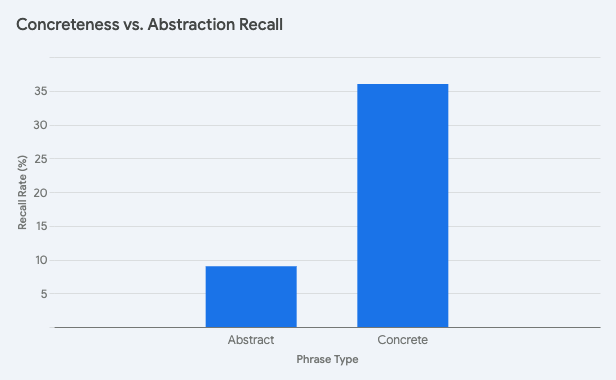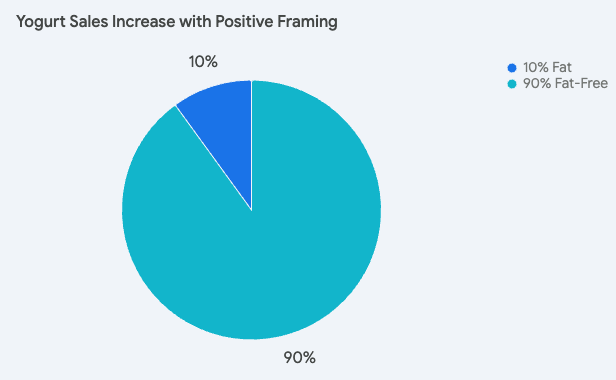If you’ve ever wondered why people buy what they buy, you’re in for a treat. Let’s dive into some fascinating, and honestly, why-don’t-we-do-this-more-often behavioral marketing examples that’ll make you rethink your strategies. Because, dude, we’re selling to PEOPLE!!
Let’s break down some killer behavioral marketing tricks that’ll make you rethink everything you thought you knew about why people buy. Get ready to blow some minds (including your own)!
1. Increasing Brand Retention: Making It Stick
Ever wonder why some brands just stick in your head? It’s all about that sweet, sweet, concrete language.
Here’s the deal: Back in ’72, psychologist Ian Begg found that people remembered 36% of concrete phrases but only 9% of abstract ones. Mind-blowing, right?
Here’s the kicker: Our most powerful sense is vision. If your language creates vivid images, it’s more memorable. Abstract terms like “quality” and “trustworthiness” don’t cut it because people can’t visualize them. Apple nailed this with the “1,000 songs in your pocket” campaign for the iPod.
This visual concreteness is a broader strategy we all should harness more.
In B2B or HRTech marketing, this principle is gold. Instead of saying, “our platform improves employee engagement,” show a clear, visual outcome: “Boost your team’s performance with daily feedback that’s as easy as texting.” Paint the picture for them.
Maren’s Pro Tip: Ditch the abstract jargon and paint a picture. Instead of “improving employee engagement,” try “turning your office into a buzzing hive of productivity.”
 Try This:
Try This:
Take your current tagline and make it more concrete. Share it with a colleague and see if they can visualize it better.
2. Rhyme Time: More Credible, More Memorable
Who knew Dr. Seuss was onto something for marketers (also did you know he created the word NERD???)? Turns out, rhymes aren’t just for nursery books – they’re secret weapons in our arsenal.
Studies show rhyming phrases are deemed 30% more believable. Why? Our brains dig that smooth, easy-to-process flow. And it gets better. When proverbs were tested for memorability, participants were twice as likely to remember the rhyming ones. Yet, the industry often ignores this simple, effective technique because consultants like to complicate things to justify their fees. It’s all about the appearance of sophistication rather than what actually works.
In the B2B space, you can incorporate this technique by using catchy, rhyming taglines or slogans in your campaigns. For instance, “Streamline your team, achieve your dream.” Simple, memorable, and more likely to be trusted.
Maren’s Pro Tip: Don’t overthink it. Simple rhymes can be sublime. “Boost your team’s dream” beats “Enhance workforce productivity” any day.
 Try This:
Try This:
Create a rhyming slogan for your next campaign. Test it against a non-rhyming version and see which one sticks.
3. Social Proof: Follow the Herd (But Make It Cool)
A hotel wanted to increase towel reuse to save resources. Instead of generic environmental messages, they placed signs saying, “75% of guests in this room reuse their towels.” Towel reuse increased by 26%.
People follow the herd, folks – use social proof to your advantage.
In B2B and HRTech marketing, showcasing how many companies or industry leaders use your product can be highly effective. Specific numbers and social proof can tip the scales in your favor.
In B2B, this is gold. Don’t just say “Join many companies using our HR software.” Hit ’em with “Join the 500+ industry leaders revolutionizing their HR with our platform.”
Maren’s Pro Tip: Use specific numbers and name-drop if you can. “Used by 7 out of 10 Fortune 500 tech companies” packs a punch.
Try This:
Identify your most impressive client statistics or testimonials. How can you feature them more prominently in your marketing?
4. The Power of Precision: Details Matter, Folks
Check this out: A fake deodorant ad claiming to reduce perspiration by 53% was seen as more credible than one claiming 50%. Why? Precision signals confidence and knowledge.
In B2B, don’t just say you’ll “reduce employee turnover.” Say you’ll “cut turnover by 37% in the first six months.” Boom. Instant credibility boost. The specificity enhances credibility and reassures potential clients.
Maren’s Pro Tip: Use odd numbers for extra impact. “Increase productivity by 73%” feels more researched than a round 75%.
Try This:
Review your current marketing claims. Can you make any of them more precise without losing accuracy?
5. Loss Aversion in Pricing: FOMO Is Your Friend
People hate losing more than they love winning. An online retailer increased annual subscriptions by 31% just by framing monthly payments as a “surcharge” instead of framing annual payments as a “discount.”
In B2B, don’t just offer a discount for annual subscriptions. Emphasize what they’re missing: “Save 20% annually – don’t let this $10,000 in savings slip away!”
In the B2B world, structure your pricing to highlight what clients might miss out on.
Instead of just offering a discount for an annual subscription, emphasize the extra costs of monthly payments: “Save 20% annually compared to monthly subscriptions. Don’t miss out on these savings!”
Maren’s Pro Tip: Create an exclusive “founders’ circle” or “early adopter” program with special perks. The fear of missing out on these benefits can be a powerful motivator.
Try This:
Identify a feature or service you could frame as an “exclusive” offer for a limited time. How would you present it to maximize FOMO?
6. The Long Game: Don’t Fall for the Short-Term Trap
Listen up, because this is crucial: Don’t get so caught up in short-term metrics that you forget the long game. Sure, price promos work now, but they can devalue your product over time.
In B2B, especially HRTech, focus on the lasting impact. Talk about sustained employee satisfaction, and reduced turnover over years, not months.
In B2B marketing, particularly in HRTech, emphasizing the long-term benefits of your product, such as sustained employee satisfaction and reduced turnover, will pay off more than short-term promotions. Create a narrative around the lasting impact of your solutions.
Maren’s Pro Tip: Create case studies that showcase long-term success stories. “How Company X Transformed Their Culture Over 5 Years” is way more powerful than a quick win.
Try This:
Outline a 5-year vision for a client using your product or service. How can you incorporate this long-term thinking into your current marketing?
7. Anchoring Effect: Set That Benchmark High
A clothing store placed a super-pricey item next to a more affordable one, and boom—sales of the cheaper item soared. That expensive piece? It’s an anchor, making everything else look like a steal.
Showcase your premium, all-bells-and-whistles package first. Suddenly, your standard offering looks like an absolute bargain.
Maren’s Pro Tip: Create a top-tier “enterprise” solution that’s almost ridiculously comprehensive. It’ll make your mid-tier option shine. Use anchoring by positioning your premium offerings alongside your standard products. Highlight the advanced features and benefits of your top-tier services to make your regular offerings seem like an excellent deal in comparison.
Try This:
Introduce a new top-tier offering in your product line. How does it change the perception of your other products?
8. Scarcity: Because We All Want What We Can’t Have
Limited edition sneakers with a countdown timer? Sold out in minutes. Scarcity creates urgency, and urgency sells.
In B2B, try “First 50 sign-ups get exclusive access to our new AI feature” or “Only 10 spots left in our master class.”
In the B2B and HRTech space, limited-time offers or exclusive features for early adopters can create a sense of urgency (ProductHunt and AppSumo have built entire models on this concept). For example, “Sign up by the end of the quarter to gain exclusive access to our new analytics feature.”
Maren’s Pro Tip: Use scarcity ethically. Don’t create fake shortages, but do highlight genuine limited opportunities.
Try This:
Identify something truly unique or limited about your offering. How can you emphasize this scarcity in your next campaign?
9. Reciprocity in Free Samples: Give to Get
Free samples aren’t just for grocery stores. That cosmetics company giving out freebies? They’re tapping into our hardwired need to reciprocate.
In B2B, offer free trials, complimentary assessments, or exclusive content. “Download our free guide to revolutionizing your HR process” can be the first step to a beautiful customer relationship. Or, offer free trials or complimentary assessments. “Get a free 30-day trial of our HR software and see the benefits firsthand,” builds trust and increases the likelihood of conversion.
Maren’s Pro Tip: Make your freebie valuable in its own right. A genuinely helpful free tool or guide builds trust and showcases your expertise.
Try This:
Create a high-value, free resource for your target audience. How can you use it to start meaningful conversations with potential clients?
10. The Power of Politeness: Ask Nicely, Get More
A University of Texas study tested two types of anti-graffiti signs: one politely asking “please don’t graffiti” and another demanding “do not graffiti.” The less polite sign resulted in twice as much graffiti. People value a sense of control and agency. If that feels restricted, they push back – a principle known as reactance. For B2B marketers, especially in HRTech, frame your calls to action politely and empoweringly.
Instead of “Sign up now!” try “We’d love to show you how we can help. Care to take a look?”
Maren’s Pro Tip: Use language that empowers the customer. “Discover how you can transform your team” beats “Let us fix your HR problems.”
Try This:
Audit your CTAs. How can you make them more polite and empowering?
11. Framing Effect in Messaging: Positive Spins Win
A food company tested two descriptions for yogurt: “90% fat-free” and “10% fat.” The “90% fat-free” version led to higher sales. Positive framing trumps negative framing, even if the information is the same.
In B2B marketing, frame your benefits positively. Instead of saying, “Reduce your downtime by 10%,” say, “Enjoy 90% uptime with our solution.” It’s all about the spin!
 Wrapping It Up: The Big Takeaway
Wrapping It Up: The Big Takeaway
Instead of motivating people to change, remove small barriers that prevent desired behaviors. Amazon’s one-click purchasing is a perfect example.
Go through your customer journey, identify blockages, and focus on removing them. It’s simple but incredibly effective.
For B2B marketers, streamline your onboarding processes and simplify the user experience. Make it easy for potential clients to say yes by reducing friction at every touchpoint. A smooth, hassle-free experience can be a game-changer.
Make it easy for people to say yes. Remove barriers, simplify processes, and guide your customers smoothly from interest to action.
Remember, we’re not just pushing products – we’re connecting with people. Use these principles responsibly, test everything, and always keep your audience’s needs at the heart of your strategy.



